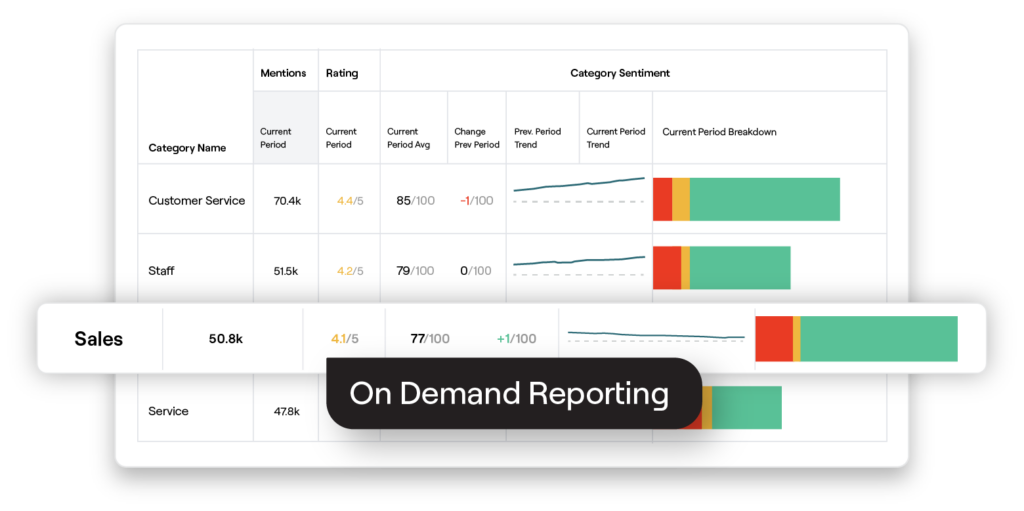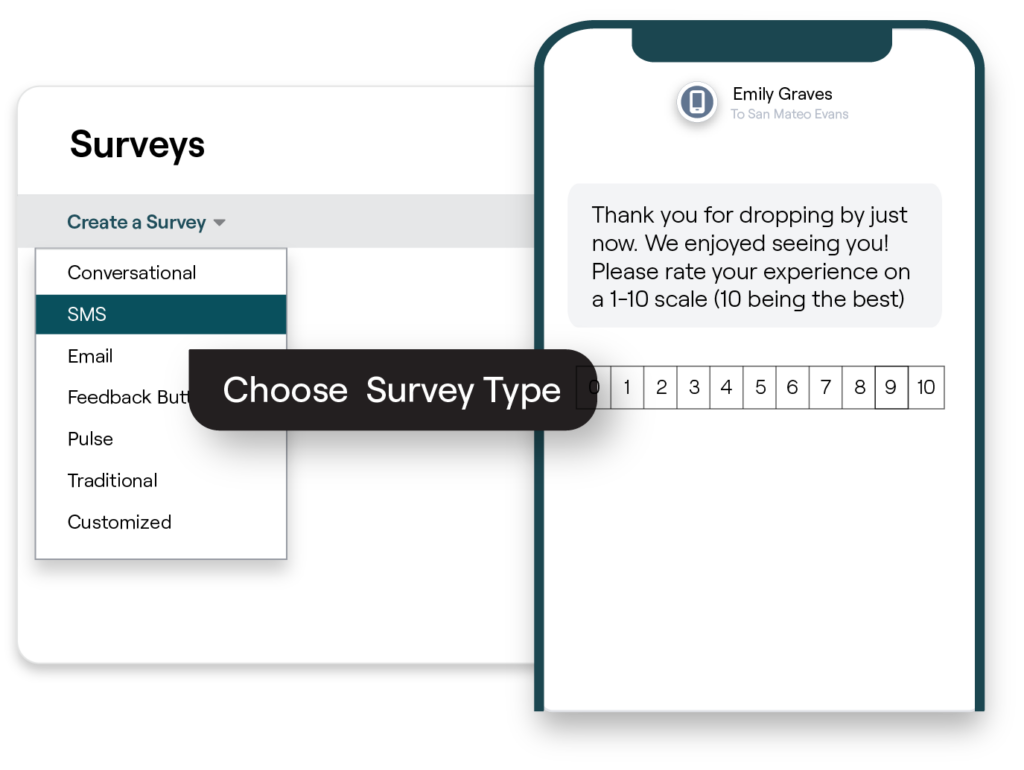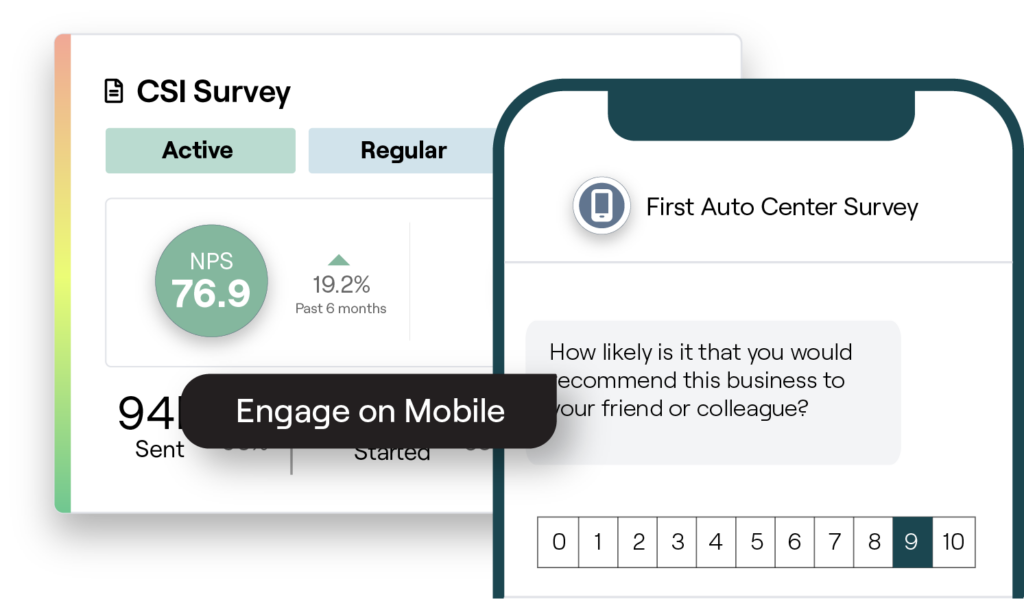Surveys in the Age of AI: A Key Component of Your Reputation Management Strategy
Reputation Staff Writer

In a world of AI-driven insights and automated feedback loops, customer surveys are becoming smarter, sharper, and more strategic than ever. We sat down with Shannon Heath, Senior Product Marketing Manager at Reputation, to discuss how brands can unlock the full power of surveys as a core component of their reputation management strategy.
Are surveys still relevant in a world dominated by reviews and social feedback?
Absolutely. While public-facing reviews and social media provide critical, real-time insights, surveys offer businesses the ability to dig deeper into the customer experience. Reputation management thrives on complete visibility, and surveys remain one of the few tools that allow brands to ask targeted questions and gather structured feedback across specific customer journeys. And surveys give voice to the silent majority—customers who may not post publicly but still have valuable insights to share.
Why should we take surveys more seriously in the age of AI?
These days, customer expectations for fast, personalized experiences are super high—and surveys are one of the most direct ways to understand and meet those expectations. For marketing and customer experience (CX) leaders, surveys offer a fast track to insights that drive messaging, service delivery, and loyalty. With AI and automation driving modern reputation management platforms, survey data can now be analyzed in real time and correlated with reviews and social feedback for a 360-degree view of customer sentiment. That kind of intelligence is just too valuable to ignore.
How exactly do surveys complement other reputation tools like reviews and listings?
Surveys provide structured feedback that reviews and listings can’t always capture. Reviews are essential for building public trust and improving discoverability, while listings ensure your business is visible where it matters. But surveys fill a critical gap by allowing brands to ask specific questions and get detailed, actionable feedback. A triangulated approach helps brands understand the why behind public sentiment, making it easier to prioritize improvements.
So, reputation management becomes far more powerful when you combine all three: Listings to ensure you’re found, reviews to build public credibility, and surveys to dive deeply into sentiment and diagnose issues. Together, they form a holistic system that supports visibility, trust, and continuous improvement.
Survey Product Demo
What kind of insights can surveys surface that public-facing reviews can’t?
Reviews tend to focus on front-facing experiences—things like wait times, pricing, or customer service. Surveys, on the other hand, can surface deeper operational issues that customers wouldn’t necessarily think of posting online, until they’re specifically asked about them.
Surveys also provide businesses the opportunity to probe deeper into the specific issues highlighted by review and social media data, allowing for more targeted insights.
They also offer the ability to test potential solutions directly with customers, gauging their reactions to proposed changes before implementing them. In reputation management, surveys can serve as a critical tool for validating which fixes are most likely to resonate with customers, enabling businesses to make informed decisions that align with customer expectations. This proactive approach helps ensure that changes are relevant and also well-received, strengthening customer satisfaction and trust. There’s huge value in that!
How do surveys help businesses uncover silent dissatisfaction or hidden issues?
Silent dissatisfaction is a serious threat to customer retention because it often goes undetected. Surveys provide a safe, private space for customers to voice concerns they might not share publicly. This is critical in reputation management, as it works with the other components of the program to identify issues businesses can resolve before they escalate— reducing churn and enhancing customer trust. When used alongside reviews and social listening, surveys round out the picture of customer sentiment and help turn passive feedback into active insights.
What are some common mistakes companies make when deploying customer surveys?
One of the most common missteps is treating surveys as a one-time box-checking exercise. Another is asking too many questions, leading to survey fatigue. Brands also sometimes use unclear or biased wording, which skews results and makes the data less useful. To get the most from surveys, businesses should treat them as an ongoing dialogue with customers—one that’s short, purposeful, and aligned with their broader reputation management objectives. Regular, well-designed surveys are more likely to yield reliable insights that translate into measurable improvements.
What’s the benefit of owning your survey program versus relying on a third-party?
Owning your survey gives you more control over the data, how it’s collected, and how it’s analyzed, which is crucial for a robust reputation management strategy. With full ownership, you can tailor the feedback process to align with your specific business needs, and that enhances your ability to track and manage customer sentiment. Relying solely on third-party platforms can limit your access to the data, making it difficult to incorporate feedback into your reputation management strategy. More importantly, third-party tools might not offer the customization needed to create a truly seamless customer experience that reinforces your brand’s reputation.
How have customer expectations around surveys changed in recent years?
Survey expectations have evolved, particularly in the context of reputation management. Today, customers expect surveys to be personalized, relevant, and easy to complete, which directly impacts your ability to manage your brand’s reputation. The need for quick, engaging, and mobile-optimized surveys is higher than ever, as customers do want their voices heard–but without feeling burdened. In addition, customers expect transparent follow-ups on how their feedback is used to improve their experience, which can also improve your brand’s reputation management efforts by showing responsiveness and dedication to customer satisfaction.
How Businesses Use Surveys to Deliver a Great Customer Experience
What makes a modern survey strategy different from legacy post-purchase emails?
Legacy email surveys tend to be one-dimensional and mainly focused on transaction-based feedback, while today’s surveys are dynamic and fully integrated into the reputation management strategy. Now, you can respond to customer feedback in ways that actively influence your brand perception. The biggest–and probably most impactful–difference is that modern surveys let you ask personalized questions for real-time insights and actionable data that reflect customers’ unique experiences with your brand. By being more adaptive and flexible, modern surveys ensure feedback is gathered from all touchpoints, providing a complete understanding of sentiment.
What kind of questions yield the most actionable data?
The most actionable survey questions are specific, concise, and tied to a clear business objective. Open-ended questions often deliver rich insights, especially when paired with AI tools that can extract trends and sentiment from unstructured text. For example, “What could we have done better?” tends to elicit feedback that can drive immediate improvements. Likewise, rating-scale questions tied to specific touchpoints—like cleanliness, wait times, or employee professionalism—can help pinpoint operational issues. In reputation management, it’s critical to design surveys that tie back to performance indicators so you can track improvements over time and benchmark against industry peers.
What’s the best way to increase survey response rates?
Increasing response rates requires a combination of thoughtful timing, clear value propositions, and ease of completion. Businesses that embed surveys into natural touchpoints—like after a service, transaction, or visit—see better participation. Offering a brief explanation of how the feedback will be used also encourages participation.
Modern reputation management platforms help by enabling mobile-friendly designs, one-click access, and even branded templates that reflect your organization’s tone and professionalism. Ultimately, the more seamless and rewarding the survey experience, the more likely customers are to participate—yielding better data to fuel your reputation management efforts.
How can surveys be used to improve specific departments, employees, or touchpoints within an organization?
Reputation management best practices require tailoring surveys to gather insights from customers at different stages of their journey. This way, businesses can pinpoint which areas of operations need improvement. For instance, customer service departments can use survey feedback to improve the quality of very specific interactions. Surveys focused on employee performance can uncover areas for growth, leading to better-trained staff who deliver a more consistent brand experience, which strengthens your overall reputation management efforts.
What new features has Reputation recently added to its survey product?
Reputation recently introduced a variety of features to its survey product, all designed to enhance the quality and effectiveness of your reputation management strategy. First is the Strength Meter, which helps elicit high-quality feedback from respondents. Second is the ability to randomize survey questions, which ensures data integrity. Both innovations enable brands to collect more accurate and actionable data, providing deeper insights into customer sentiment and ultimately improving reputation management effectiveness.
How does the new Strength Meter improve the quality of feedback?
The Strength Meter analyzes the depth and specificity of responses. It’s a visual indicator that measures the quality of the response and guides users towards stronger, more valuable feedback. Deeper, more detailed insights makes it easier for brands to more quickly identify and prioritize areas that require immediate attention.
See the Reputation Platform in Action
Why is randomizing survey questions important, and how does it improve data integrity?
Randomized survey questions take your reputation management strategy to the next level. Because when questions are presented in a consistent order, respondents can become influenced by the pattern, and that can skew results. By randomizing the questions, you ensure responses are more authentic and unbiased, leading to higher-quality data that truly reflects customer opinions. This helps businesses make more informed decisions about their approach to reputation management–by ensuring that any actions taken are based on genuine customer insights rather than patterns or biases in the survey process.
Can surveys actually influence online reputation management if they’re not public-facing?
Oh, surveys can have a significant impact on reputation management–whether or not they’re public-facing. Earlier, we talked about how surveys can activate the silent majority, giving your customers a private, more direct channel for sharing deeper, more meaningful feedback. These private surveys allow businesses to gather feedback from those customers and employees before any issues become public. By proactively addressing concerns, brands can improve customer satisfaction, leading to more positive online reviews. And the data collected through non-public surveys can be used to refine strategies and resolve problems behind the scenes, ultimately influencing the public perception of your brand and boosting reputation management efforts.
How do high-performing organizations integrate survey feedback with review and social sentiment data?
High-performers view survey feedback as part of a comprehensive reputation management strategy that includes reviews and social media. By combining these data sources, companies can develop a more complete understanding of customer perception, identifying trends and potential issues across multiple channels. And that integration enables brands to craft more personalized and proactive responses, improve customer experience, refine products or services, and strengthen their brand.
How do survey results impact operations, marketing, or employee training?
Survey results can have a direct impact on all three. In operations, survey insights can identify inefficiencies or areas of improvement, which can be addressed in ways that enhance the customer experience. For marketing, survey data provides actionable insights that can guide campaigns, helping brands tailor messaging to align with customer expectations and sentiment. And survey results can be used to very effectively guide employee training by pinpointing areas where the staff needs additional support or education, which helps ensure every interaction positively influences the brand’s reputation.
What are the most common mistakes businesses make when implementing surveys?
One of the most common survey mistakes is not tying the results back to their reputation management strategy. Failing to act on feedback or not personalizing the questions can lead to disengagement and poor response rates. When surveys are poorly structured or too time-consuming, response rates plummet and the data becomes unreliable. And businesses often overlook timing. Sending surveys too soon, too late, or without context can skew results. Additionally, businesses sometimes neglect to integrate survey data with other reputation metrics like reviews or social sentiment, missing out on valuable insights that could strengthen their reputation management efforts. To avoid these pitfalls, companies need to treat surveys as a vital tool in shaping their brand perception.
Surveys Provide a Deeper Understanding of Your Consumers



What role does timing play in maximizing survey response rates?
Timing is essential to ensuring the effectiveness of your reputation management efforts. Surveys should be sent at moments when customers are most likely to engage—that would be immediately following a service interaction, a purchase, or a touchpoint that directly impacts their perception of your brand. Timing the surveys appropriately allows a business to capture fresh, relevant feedback while it’s still top of mind. And that helps to ensure the data collected is both accurate and actionable.
How can brands use survey data to get ahead of potential reputation issues?
By regularly collecting feedback, brands can identify emerging issues or dissatisfaction before they escalate into public reputation challenges. And again–acting on survey feedback allows businesses to refine their products, services, or customer interactions to address concerns early on. By addressing potential issues before they become widely known, companies can maintain a positive reputation and show customers they are dedicated to continuous improvement, which is a crucial aspect of effective reputation management.
What’s the ideal length and structure for a modern customer feedback survey?
The ideal customer feedback survey is concise, usually 5-10 questions, with a mix of both quantitative and qualitative questions that allow businesses to collect actionable data. It should be structured to gather specific insights into customer experiences, and every question should serve a clear purpose in supporting the broader reputation management strategy. Surveys should be mobile-optimized, easy to complete, and avoid overwhelming customers. A short, well-structured survey is more likely to get higher response rates and provide valuable feedback with the power to impact the organization.
What types of businesses benefit most from survey-driven reputation management?
Every business can benefit, but multi-location brands, healthcare providers, retail chains, and service-driven industries see especially strong returns from survey-driven reputation management. These businesses rely heavily on consistency across locations, and surveys allow them to identify patterns, benchmark performance, and act quickly on localized issues. In industries where every interaction counts—like patient care, hospitality, or automotive sales—surveys provide the structured feedback needed to elevate the customer experience and enhance long-term brand equity.
What advice would you give to a brand that’s underutilizing its surveys feature today?
My advice is to get started! Surveys are a key component of your reputation management strategy. Begin by identifying clear goals for the surveys—whether it’s gathering customer feedback, improving product offerings, or assessing employee performance. Use surveys to engage with customers at every stage of the journey, and act on the feedback to show that you value their input. Integrate survey data with your review and social sentiment data to gain a comprehensive view of customer sentiment. Adding surveys to your overall strategy will help you considerably improve your reputation in the shortest time possible.










